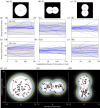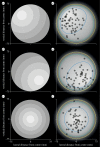Finding the gap: a brightness-based strategy for guidance in cluttered environments
- PMID: 27053748
- PMCID: PMC4843647
- DOI: 10.1098/rspb.2015.2988
Finding the gap: a brightness-based strategy for guidance in cluttered environments
Abstract
The ability to move safely between obstacles is critical for animals that fly rapidly through cluttered environments but surprisingly little is known about how they achieve this. Do they reactively avoid obstacles or do they instead fly towards the gaps between them? If they aim towards gaps, what information do they use to detect and fly through them? Here, we aim to answer these questions by presenting orchid bees with different apertures. When negotiating gaps, orchid bees locate and fly close to the point that gives them greatest clearance from the edges. The cue that they use to pinpoint this spot is the brightness gradient formed across the aperture. Furthermore, we find that orchid bees also rely on brightness cues to locate gaps that are sufficiently large to negotiate safely. The advantage of using brightness for locating and negotiating gaps in a cluttered environment is that it provides information about the safest path through obstacles, at least in a forest environment. This brightness-based guidance strategy for gap detection and negotiation represents a fast, computationally simple and efficient mechanism to identify the clearest path through a forest and is, therefore, likely to represent a more general mechanism used by other animals.
Keywords: brightness; flight; guidance; insect; orchid bee; vision.
© 2016 The Author(s).
Figures






References
-
- Lin H-T, Ros IG, Biewener AA. 2014. Through the eyes of a bird: modelling visually guided obstacle flight. J. R. Soc. Interface 11, 20140239 (doi:10.1098/rsif.2014.0239) - DOI - PMC - PubMed
-
- Bhagavatula Partha S, Claudianos C, Ibbotson Michael R, Srinivasan Mandyam V. 2011. Optic flow cues guide flight in birds. Curr. Biol. 21, 1794–1799. (doi:10.1016/j.cub.2011.09.009) - DOI - PubMed
-
- Dyhr JP, Higgins CM. 2010. The spatial frequency tuning of optic-flow-dependent behaviours in the bumblebee Bombus impatiens. J. Exp. Biol. 213, 1643–1650. (doi:10.1242/jeb.041426) - DOI - PMC - PubMed
-
- Portelli G, Serres J, Ruffier F, Franceschini N. 2010. Modelling honeybee visual guidance in a 3-D environment. J. Physiol. Paris 104, 27–39. (doi:10.1016/j.jphysparis.2009.11.011) - DOI - PubMed
-
- Srinivasan MV, Lehrer M, Kirchner WH, Zhang SW. 1991. Range perception through apparent image speed in freely flying honeybees. Vis. Neurosci. 6, 519–535. (doi:10.1017/S095252380000136X) - DOI - PubMed
Publication types
MeSH terms
Associated data
LinkOut - more resources
Full Text Sources
Other Literature Sources
Miscellaneous

